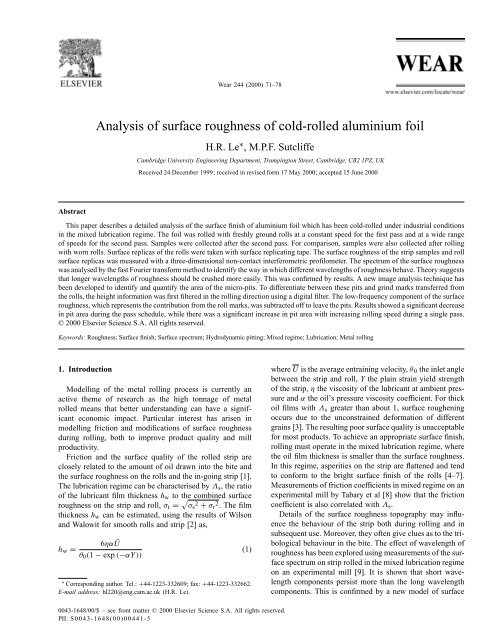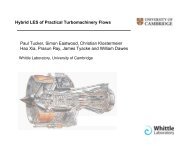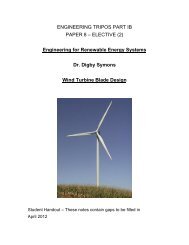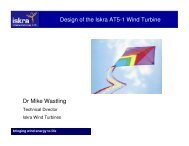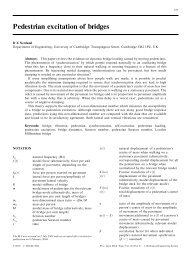Analysis of surface roughness of cold-rolled aluminium foil
Analysis of surface roughness of cold-rolled aluminium foil
Analysis of surface roughness of cold-rolled aluminium foil
Create successful ePaper yourself
Turn your PDF publications into a flip-book with our unique Google optimized e-Paper software.
Abstract<br />
Wear 244 (2000) 71–78<br />
<strong>Analysis</strong> <strong>of</strong> <strong>surface</strong> <strong>roughness</strong> <strong>of</strong> <strong>cold</strong>-<strong>rolled</strong> <strong>aluminium</strong> <strong>foil</strong><br />
H.R. Le ∗ , M.P.F. Sutcliffe<br />
Cambridge University Engineering Department, Trumpington Street, Cambridge, CB2 1PZ, UK<br />
Received 24 December 1999; received in revised form 17 May 2000; accepted 15 June 2000<br />
This paper describes a detailed analysis <strong>of</strong> the <strong>surface</strong> finish <strong>of</strong> <strong>aluminium</strong> <strong>foil</strong> which has been <strong>cold</strong>-<strong>rolled</strong> under industrial conditions<br />
in the mixed lubrication regime. The <strong>foil</strong> was <strong>rolled</strong> with freshly ground rolls at a constant speed for the first pass and at a wide range<br />
<strong>of</strong> speeds for the second pass. Samples were collected after the second pass. For comparison, samples were also collected after rolling<br />
with worn rolls. Surface replicas <strong>of</strong> the rolls were taken with <strong>surface</strong> replicating tape. The <strong>surface</strong> <strong>roughness</strong> <strong>of</strong> the strip samples and roll<br />
<strong>surface</strong> replicas was measured with a three-dimensional non-contact interferometric pr<strong>of</strong>ilometer. The spectrum <strong>of</strong> the <strong>surface</strong> <strong>roughness</strong><br />
was analysed by the fast Fourier transform method to identify the way in which different wavelengths <strong>of</strong> <strong>roughness</strong> behave. Theory suggests<br />
that longer wavelengths <strong>of</strong> <strong>roughness</strong> should be crushed more easily. This was confirmed by results. A new image analysis technique has<br />
been developed to identify and quantify the area <strong>of</strong> the micro-pits. To differentiate between these pits and grind marks transferred from<br />
the rolls, the height information was first filtered in the rolling direction using a digital filter. The low-frequency component <strong>of</strong> the <strong>surface</strong><br />
<strong>roughness</strong>, which represents the contribution from the roll marks, was subtracted <strong>of</strong>f to leave the pits. Results showed a significant decrease<br />
in pit area during the pass schedule, while there was a significant increase in pit area with increasing rolling speed during a single pass.<br />
© 2000 Elsevier Science S.A. All rights reserved.<br />
Keywords: Roughness; Surface finish; Surface spectrum; Hydrodynamic pitting; Mixed regime; Lubrication; Metal rolling<br />
1. Introduction<br />
Modelling <strong>of</strong> the metal rolling process is currently an<br />
active theme <strong>of</strong> research as the high tonnage <strong>of</strong> metal<br />
<strong>rolled</strong> means that better understanding can have a significant<br />
economic impact. Particular interest has arisen in<br />
modelling friction and modifications <strong>of</strong> <strong>surface</strong> <strong>roughness</strong><br />
during rolling, both to improve product quality and mill<br />
productivity.<br />
Friction and the <strong>surface</strong> quality <strong>of</strong> the <strong>rolled</strong> strip are<br />
closely related to the amount <strong>of</strong> oil drawn into the bite and<br />
the <strong>surface</strong> <strong>roughness</strong> on the rolls and the in-going strip [1].<br />
The lubrication regime can be characterised by Λs, the ratio<br />
<strong>of</strong> the lubricant film thickness hw to the combined <strong>surface</strong><br />
<strong>roughness</strong> on the strip and roll, σt = σs 2 + σr 2 . The film<br />
thickness hw can be estimated, using the results <strong>of</strong> Wilson<br />
and Walowit for smooth rolls and strip [2] as,<br />
hw =<br />
6ηαŪ<br />
θ0(1 − exp (−αY))<br />
∗ Corresponding author. Tel.: +44-1223-332609; fax: +44-1223-332662.<br />
E-mail address: hl220@eng.cam.ac.uk (H.R. Le).<br />
0043-1648/00/$ – see front matter © 2000 Elsevier Science S.A. All rights reserved.<br />
PII: S0043-1648(00)00441-5<br />
(1)<br />
where U is the average entraining velocity, θ 0 the inlet angle<br />
between the strip and roll, Y the plain strain yield strength<br />
<strong>of</strong> the strip, η the viscosity <strong>of</strong> the lubricant at ambient pressure<br />
and α the oil’s pressure viscosity coefficient. For thick<br />
oil films with Λs greater than about 1, <strong>surface</strong> roughening<br />
occurs due to the unconstrained deformation <strong>of</strong> different<br />
grains [3]. The resulting poor <strong>surface</strong> quality is unacceptable<br />
for most products. To achieve an appropriate <strong>surface</strong> finish,<br />
rolling must operate in the mixed lubrication regime, where<br />
the oil film thickness is smaller than the <strong>surface</strong> <strong>roughness</strong>.<br />
In this regime, asperities on the strip are flattened and tend<br />
to conform to the bright <strong>surface</strong> finish <strong>of</strong> the rolls [4–7].<br />
Measurements <strong>of</strong> friction coefficients in mixed regime on an<br />
experimental mill by Tabary et al [8] show that the friction<br />
coefficient is also correlated with Λs.<br />
Details <strong>of</strong> the <strong>surface</strong> <strong>roughness</strong> topography may influence<br />
the behaviour <strong>of</strong> the strip both during rolling and in<br />
subsequent use. Moreover, they <strong>of</strong>ten give clues as to the tribological<br />
behaviour in the bite. The effect <strong>of</strong> wavelength <strong>of</strong><br />
<strong>roughness</strong> has been explored using measurements <strong>of</strong> the <strong>surface</strong><br />
spectrum on strip <strong>rolled</strong> in the mixed lubrication regime<br />
on an experimental mill [9]. It is shown that short wavelength<br />
components persist more than the long wavelength<br />
components. This is confirmed by a new model <strong>of</strong> <strong>surface</strong>
72 H.R. Le, M.P.F. Sutcliffe / Wear 244 (2000) 71–78<br />
Nomenclature<br />
f sampling frequency <strong>of</strong> <strong>surface</strong><br />
measurement, f=1/<br />
Fj<br />
(j=0,...,n/2−1) complex FFT coefficients <strong>of</strong> a<br />
data array<br />
hi (i=1,...,n) data array <strong>of</strong> <strong>surface</strong> heights<br />
hw<br />
smooth film thickness using the<br />
Wilson and Walowit formula<br />
H ( H ˜ ) matrix <strong>of</strong> <strong>surface</strong> heights (after<br />
low-pass filtering)<br />
s2 (λ1,λ2) <strong>surface</strong> variance <strong>of</strong> the wavelength<br />
between λ1 and λ2<br />
S single-sided power spectral density<br />
U average entraining velocity,<br />
U=(Ur+Us)/2<br />
¯w mean square <strong>of</strong> a window vector,<br />
¯w = wi 2 /n<br />
wi (i=1,...,n) window vector<br />
Y plane strain yield stress <strong>of</strong> the strip<br />
Greek symbols<br />
α oil pressure viscosity index<br />
θ 0 inlet angle between the strip and roll (radians)<br />
δ depth <strong>of</strong> pits<br />
∆ sampling distance <strong>of</strong> <strong>surface</strong> measurement<br />
η oil viscosity at ambient pressure<br />
λ wavelength <strong>of</strong> the <strong>surface</strong> spectrum<br />
σ r r.m.s. <strong>surface</strong> <strong>roughness</strong> on the rolls<br />
σ s r.m.s. <strong>surface</strong> <strong>roughness</strong> on the strip<br />
σ t combined r.m.s. <strong>surface</strong> <strong>roughness</strong> <strong>of</strong><br />
the strip and roll<br />
σ 2 (λ) variance <strong>of</strong> all wavelengths >λ<br />
flattening [10], in which the <strong>surface</strong> <strong>roughness</strong> is modelled as<br />
two wavelengths. Several authors have identified various features<br />
on the strip <strong>surface</strong>s. For example, Gjønnes [11] used<br />
laser-scanning microscopy to identify grooves, roll ridges<br />
and ‘shingles’ on <strong>cold</strong>-<strong>rolled</strong> <strong>aluminium</strong> while Ohkubo et al.<br />
[12] investigated the influence on the <strong>surface</strong> gloss <strong>of</strong> <strong>aluminium</strong><br />
<strong>foil</strong> <strong>of</strong> oil pits, ‘slags’, roll marks and small depressions.<br />
Staeves and Schmoeckel [13] relate the tribological<br />
behaviour to the <strong>surface</strong> topography. Ahmed and Sutcliffe<br />
[14] describe a method for analysing three-dimensional <strong>surface</strong><br />
topography obtained from <strong>cold</strong>-<strong>rolled</strong> stainless steel<br />
samples to identify hydrodynamic pits and roll marks on the<br />
<strong>surface</strong>, by considering the local differences in height between<br />
the pits and the un-pitted regions. This is particularly<br />
suited to the stainless steel case where pits are the dominant<br />
features. Although that method has been applied by Le<br />
and Sutcliffe [15] to the <strong>aluminium</strong> <strong>foil</strong> samples described<br />
in this paper, this paper describes a more efficient algorithm<br />
which is better suited to <strong>aluminium</strong> <strong>foil</strong> where roll marks<br />
are the dominant feature.<br />
The purpose <strong>of</strong> this paper is to look at the details <strong>of</strong> the<br />
<strong>surface</strong> <strong>of</strong> <strong>aluminium</strong> <strong>foil</strong> <strong>rolled</strong> under industrial conditions,<br />
to confirm the results <strong>of</strong> the laboratory-scale tests and to<br />
provide benchmarks for the theoretical models currently being<br />
developed. The spectral analysis <strong>of</strong> <strong>surface</strong> <strong>roughness</strong><br />
described in Ref. [16] is applied to the measured <strong>surface</strong><br />
data. Section 2 <strong>of</strong> this paper describes the details <strong>of</strong> the strip<br />
samples and measurements <strong>of</strong> <strong>surface</strong> <strong>roughness</strong>. Observations<br />
<strong>of</strong> the <strong>surface</strong> feature are described in Section 3. The<br />
methodology <strong>of</strong> spectral and hydrodynamic pit analysis is<br />
described in Section 4. Section 5 presents the results, and<br />
conclusions are given in Section 6.<br />
2. Experimental procedure<br />
2.1. Collection <strong>of</strong> samples<br />
A coil <strong>of</strong> 1200 <strong>aluminium</strong> alloy <strong>of</strong> initial strip <strong>of</strong> thickness<br />
0.4 mm was <strong>rolled</strong> under industrial conditions at a constant<br />
speed for the first pass and at a wide range <strong>of</strong> speeds for<br />
the second pass using freshly ground rolls. The reduction<br />
in strip thickness during both passes was ≈50%. Lubricant<br />
was applied abundantly on both sides <strong>of</strong> the strip. Samples<br />
<strong>of</strong> the initial strip were collected from the end <strong>of</strong> the coil.<br />
After the first pass, a sample was taken from a region where<br />
the coil was being <strong>rolled</strong> at speed. Changes in speed during<br />
the second pass were marked on the side <strong>of</strong> the coil. These<br />
were used to identify the rolling speed <strong>of</strong> samples that were<br />
collected from the middle <strong>of</strong> the coil, which was scrapped<br />
after this pass. Samples <strong>rolled</strong> with worn rolls under similar<br />
conditions were collected for comparison. Replicas <strong>of</strong><br />
the roll <strong>surface</strong> were taken before the second pass using<br />
Press-O-Film <strong>surface</strong>-replicating tape supplied by Testex.<br />
2.2. Measurements <strong>of</strong> <strong>surface</strong> <strong>roughness</strong><br />
Surface <strong>roughness</strong> was measured in a Zygo non-contacting<br />
three-dimensional interferometric pr<strong>of</strong>ilometer. The equipment<br />
has a lateral resolution <strong>of</strong> 0.5 m and vertical resolution<br />
<strong>of</strong> 0.1 nm.<br />
2.2.1. Preparation <strong>of</strong> samples<br />
It is very important to use flat samples, a problem that<br />
is especially relevant for thin <strong>foil</strong> and the replica tape. To<br />
ensure this, the samples are carefully cut, trimmed and stuck<br />
onto a glass slide. The <strong>surface</strong>s <strong>of</strong> the strip samples were<br />
cleaned with acetone to remove residual lubricant before<br />
measurements were taken.<br />
2.2.2. Measurements<br />
A20× objective lens was used to ensure that the field<br />
<strong>of</strong> view and depth <strong>of</strong> field are sufficient to take in the<br />
relevant <strong>surface</strong> features. For <strong>surface</strong> <strong>roughness</strong> measurements,<br />
a magnification <strong>of</strong> 200 is used. Normally, 10 areas are<br />
measured and averaged to give the average r.m.s <strong>roughness</strong>
Table 1<br />
Details <strong>of</strong> the measurements<br />
Magnification Field <strong>of</strong><br />
view (mm)<br />
Depth <strong>of</strong><br />
view (m)<br />
200 0.71×0.53 3.5 2.2<br />
400 0.35×0.26 3.5 1.1<br />
800 0.17×0.13 3.5 0.55<br />
H.R. Le, M.P.F. Sutcliffe / Wear 244 (2000) 71–78 73<br />
Sampling<br />
distance (m)<br />
and standard error. For spectrum and hydrodynamic pit analyses,<br />
a magnification <strong>of</strong> 400 or 800 is used. Details <strong>of</strong> the<br />
measurements are listed in Table 1.<br />
3. Observations <strong>of</strong> <strong>surface</strong> features<br />
In order to analyse the <strong>surface</strong>s, the <strong>surface</strong> heights on<br />
a two-dimensional grid are exported from the pr<strong>of</strong>ilometer<br />
to a computer for analysis in Matlab. The columns <strong>of</strong> the<br />
height matrix H correspond to changes in <strong>surface</strong> height in<br />
the rolling direction and the rows correspond to the transverse<br />
direction. Surface maps <strong>of</strong> the initial strip are shown in<br />
Fig. 1. The <strong>surface</strong> height is shown on the grey scale at the<br />
side <strong>of</strong> the figure. On both the top and bottom <strong>surface</strong>s, the<br />
<strong>surface</strong> topography is dominated by roll marks running in<br />
the rolling direction, but there are also a number <strong>of</strong> isolated<br />
Fig. 1. Surface maps for the initial strip <strong>of</strong>: (a) top <strong>surface</strong> (400×); and<br />
(b) bottom <strong>surface</strong> (400×).<br />
micro-pits. Clearly the roll marks are transferred directly<br />
from the roll topography. However, the origin <strong>of</strong> these pits is<br />
unclear. Suggestions that they may arise from unconstrained<br />
deformation, in the regions where there is an oil film between<br />
the <strong>surface</strong>s [3], seem to be confirmed by the way that the<br />
pits in Fig. 1a are strung along in rows running in the rolling<br />
direction. Once created, these pits may persist for several<br />
passes before they can be eliminated (c.f. Ref. [14]). It is<br />
interesting to note that the bottom <strong>surface</strong> is much rougher<br />
than the top <strong>surface</strong>, with more closely spaced and much<br />
higher ridges but fewer pits. These differences presumably<br />
arise from differences in roll <strong>roughness</strong> and lubrication conditions<br />
between the top and bottom <strong>surface</strong>s in the previous<br />
passes. The roll marks seem to be widely spaced on the<br />
initial strip with a wavelength <strong>of</strong> about 100 m. The <strong>surface</strong><br />
maps <strong>of</strong> the first and second passes are shown in Fig. 2. It<br />
appears that, during these subsequent passes, the wavelength<br />
<strong>of</strong> roll marks becomes less uniform and that micro-pits on<br />
the <strong>surface</strong> are smaller than those on the initial strip.<br />
4. Surface analysis<br />
In this section, the change in <strong>surface</strong> topography during<br />
rolling, which can clearly be observed from the <strong>surface</strong><br />
Fig. 2. Surface height maps for the top <strong>surface</strong> <strong>of</strong> strip: (a) after first pass<br />
(800×); and (b) after second pass (800×).
74 H.R. Le, M.P.F. Sutcliffe / Wear 244 (2000) 71–78<br />
maps, Figs. 1 and 2, will be quantified, both to help characterise<br />
these <strong>surface</strong> changes and to provide a more objective<br />
definition <strong>of</strong> the changes in <strong>surface</strong> topography. In Section<br />
4.1, a spectral analysis <strong>of</strong> the <strong>surface</strong>s is described, while<br />
Section 4.2 outlines a method for identifying micro-pits.<br />
4.1. Spectrum analysis<br />
For a given one-dimensional discrete data array <strong>of</strong> the <strong>surface</strong><br />
heights, hi,(i=1,...,n), the single-sided power spectral<br />
density S (1/λ) can be found using a fast Fourier transformation<br />
(FFT) [17,18] with a Hanning window [19].<br />
<br />
1<br />
S<br />
λj<br />
= 2Fj F j<br />
nwf<br />
, j = 0,... ,n − 1 (2)<br />
2<br />
where Fj is a FFT coefficient <strong>of</strong> the data array, ¯Fj the conjugate<br />
<strong>of</strong> Fj , ¯w the mean square <strong>of</strong> the window factor, ¯w =<br />
( w2 i )/n, and f the sampling frequency, f=1/∆. The corresponding<br />
frequency is 1/λj =jf/n, (j=0,..., n/2−1).<br />
Now, S (1/λj) represents the contribution to the variance<br />
<strong>of</strong> heights <strong>of</strong> the component with wavelength λj. Therefore,<br />
the contribution between wavelengths λ1 and λ2 is given by<br />
1/λ1<br />
<br />
s 2 (λ1,λ2) =<br />
1/λ2<br />
S<br />
1<br />
λ<br />
d<br />
1<br />
λ<br />
Taking a fixed upper cut-<strong>of</strong>f at the value <strong>of</strong> 200 m to eliminate<br />
waviness in the strip, σ 2 (λ)=s 2 (λ, 200 m) represents<br />
a cumulative <strong>roughness</strong> variance including all wavelengths<br />
>λ, but less than the upper cut-<strong>of</strong>f.<br />
For each row <strong>of</strong> data, the one-dimensional FFT is used<br />
to find the spectrum <strong>of</strong> the <strong>surface</strong> <strong>roughness</strong> across the<br />
rolling direction. Spectra for all the rows in the measured<br />
area are averaged to give an average spectral density across<br />
the rolling direction and the corresponding cumulative variance<br />
σ 2 .<br />
4.2. Identification <strong>of</strong> roll marks and micro-pits<br />
Although the <strong>surface</strong> <strong>roughness</strong> is mainly characterised<br />
by longitudinal roll marks, micro-pits become more prevalent<br />
at high rolling speeds. To identify these features, a<br />
zero-phase forward and reverse digital filter (filtfilt in Matlab<br />
[19]) is applied to each column <strong>of</strong> the height matrix H,<br />
using a 4th-order low-pass Butterworth filter, with a cut-<strong>of</strong>f<br />
wavelength <strong>of</strong> λr, typically <strong>of</strong> 25–50 m. The filtered height<br />
signal H ˜ , containing wavelengths longer than λr, is taken as<br />
corresponding to the roll marks. This is illustrated in Fig. 3a<br />
which shows the roll marks corresponding to the <strong>surface</strong> map<br />
<strong>of</strong> Fig. 1a. The roll marks are then subtracted from the height<br />
array H to essentially leave the micro-pits. To discriminate<br />
between the pits and any ‘noise’ in the signal, only regions<br />
which are deeper than a critical value δ are identified as pits.<br />
Typically, 0.1
Fig. 4. Roughness amplitude (r.m.s.) <strong>of</strong> strip samples. (a) Change during<br />
the pass schedule; and (b) the effect <strong>of</strong> Λs during the second pass.<br />
bottom <strong>surface</strong> <strong>of</strong> the initial strip is significantly greater<br />
than on the top <strong>surface</strong>, as observed in Fig. 1. Nevertheless,<br />
both sides <strong>of</strong> the <strong>surface</strong> have nearly conformed to the roll<br />
<strong>surface</strong> after the first pass, so that the difference between the<br />
two sides is then negligible. In the second pass, the <strong>surface</strong><br />
<strong>roughness</strong> is further reduced slightly. The high degree to<br />
which the strip conforms to the roll <strong>surface</strong> reflects the small<br />
value <strong>of</strong> lubrication parameter Λs, which is about 0.04 for<br />
the first pass and varies between 0.015 and 0.08 for the<br />
second pass.<br />
Fig. 4b shows the effect <strong>of</strong> Λs, which is proportional to<br />
rolling speed, on the r.m.s <strong>surface</strong> <strong>roughness</strong> after the second<br />
pass. Since the <strong>surface</strong> <strong>roughness</strong> on both the incoming and<br />
outgoing strip is close to that <strong>of</strong> the rolls, any effect <strong>of</strong><br />
Λs on <strong>surface</strong> <strong>roughness</strong> is overshadowed by scatter in the<br />
measurements. Nevertheless, there appears to be a slight<br />
increase in the <strong>surface</strong> <strong>roughness</strong> at very small Λs, which<br />
may be associated with a breakdown <strong>of</strong> lubrication.<br />
5.2. Surface spectrum<br />
Fig. 5 shows the change in the <strong>surface</strong> spectrum during<br />
the pass schedule. The contribution <strong>of</strong> long wavelength<br />
H.R. Le, M.P.F. Sutcliffe / Wear 244 (2000) 71–78 75<br />
Fig. 5. The change in the strip <strong>surface</strong> spectrum during rolling: (a) spectral<br />
density; and (b) cumulative <strong>surface</strong> variance, normalised by the strip<br />
<strong>roughness</strong> variance.<br />
components to the <strong>surface</strong> <strong>roughness</strong> falls through the pass<br />
schedule as these components are crushed. The increase in<br />
the high-frequency components (30–100 mm −1 ) in the first<br />
pass arises as the strip conforms to the fresh rolls used for<br />
this pass, which contain large high-frequency components.<br />
Presumably worn rolls were used to produce the initial strip<br />
<strong>surface</strong>, giving only a small high-frequency component to<br />
the ingoing strip. Although the <strong>surface</strong> <strong>roughness</strong> amplitude<br />
<strong>of</strong> the strip after the first pass approaches that <strong>of</strong> the roll<br />
<strong>surface</strong>, there is an increase in the relative composition <strong>of</strong><br />
short wavelength components during the second pass, as the<br />
long wavelengths are crushed more readily. This is in line<br />
with the results <strong>of</strong> laboratory experiments [9] and predictions<br />
from theory [10]. Fig. 5b shows that, for the second<br />
pass, there is no significant effect <strong>of</strong> rolling speed on the<br />
<strong>surface</strong> spectra. By this pass the actual changes in <strong>roughness</strong><br />
are slight, and any effect due to differences in hydrodynamic<br />
oil entrainment at these small values <strong>of</strong> Λs is too small to<br />
be detectable.<br />
Fig. 6 illustrates the change in <strong>surface</strong> spectrum from<br />
fresh to worn rolls. Fig. 6a plots the spectral density and
76 H.R. Le, M.P.F. Sutcliffe / Wear 244 (2000) 71–78<br />
Fig. 6. The effect <strong>of</strong> roll <strong>roughness</strong> on strip <strong>surface</strong> spectrum: (a) spectral<br />
density; and (b) cumulative <strong>surface</strong> variance, normalised by the strip<br />
<strong>roughness</strong> variance.<br />
Fig. 6b plots the cumulative variance, normalised by the<br />
r.m.s. <strong>roughness</strong> <strong>of</strong> each roll replica. Fig. 6a shows that<br />
short wavelength components are most rapidly reduced in<br />
amplitude as the roll wears. The way in which the roll <strong>surface</strong><br />
imprints on the strip <strong>surface</strong> can be seen from the change<br />
in shape <strong>of</strong> the curves, Fig. 6b. The relative contribution<br />
from wavelengths 200 mm −1 ), given by the<br />
difference between one and the cumulative variance at this<br />
frequency, is significantly greater for the strip <strong>rolled</strong> with a<br />
fresh roll than for the strip with the worn rolls. This reflects<br />
the reduction in short wavelength components on the roll<br />
<strong>surface</strong> as the rolls wear.<br />
5.3. Variation <strong>of</strong> hydrodynamic pits<br />
Fig. 7 shows the results <strong>of</strong> the pitting analysis for the first<br />
pass at a single speed and for the second pass at two rolling<br />
speeds. The dark regions on the maps shown in Fig. 7 identify<br />
the pits. The corresponding map <strong>of</strong> pits for the initial<br />
strip is given in Fig. 3c. The fraction <strong>of</strong> the total area taken<br />
Fig. 7. Identification <strong>of</strong> pits for: (a) first pass; (b) second pass (Λs=0.015);<br />
and (c) second pass (Λs=0.08); λr=25 m, δ=0.25 m.<br />
up by pits is quantified and plotted against pass number in<br />
Fig. 8a and against Λs in Fig. 8b, for two values <strong>of</strong> pit depth<br />
tolerance δ. Each point represents an average over an area <strong>of</strong><br />
0.35×0.25 mm 2 . The estimated area <strong>of</strong> pitting is larger for<br />
the smaller value <strong>of</strong> δ. Also including shallower pits using<br />
the smaller δ, some points are spuriously identified as pits.<br />
The curve for δ=0.25 m is, probably, to be preferred, unless<br />
the smaller pits are expected to play a significant role<br />
in subsequent operations. A value <strong>of</strong> δ equal to 0.25 m<br />
corresponds to about 60% <strong>of</strong> the Rq <strong>roughness</strong> <strong>of</strong> the rolls.<br />
Ahmed and Sutcliffe [14] come to similar conclusions about<br />
the appropriate choice <strong>of</strong> pit tolerance parameter using their
Fig. 8. Pitting area <strong>of</strong> strip samples: (a) change during the pass schedule;<br />
and (b) the effect <strong>of</strong> Λs during the second pass.<br />
alternative identification algorithm. Fig. 8a confirms the visual<br />
impression obtained from Fig. 7, that the area <strong>of</strong> pits<br />
is significantly reduced during the schedule. It can also be<br />
seen from Fig. 3c and Fig. 7 that the deep pits are reduced<br />
in size and area by each pass. Fig. 8b shows that, for the<br />
second pass, there is a significant increase in pit area with<br />
increasing Λs. This suggests that hydrodynamic action may<br />
prevent the elimination <strong>of</strong> the pits.<br />
The earlier analysis <strong>of</strong> Le and Sutcliffe [15] gave quantitatively<br />
similar results for the pitting analysis as those<br />
presented here for δ=0.25 m. Their method, which uses<br />
a linear least-squares fit to data in the rolling direction to<br />
eliminate the roll marks, falls half-way between the approach<br />
described in this paper and the ad-hoc and more<br />
complicated approach described by Ahmed and Sutcliffe<br />
[14] for considering local differences in <strong>surface</strong> height to<br />
identify pits. For the <strong>aluminium</strong> <strong>foil</strong> <strong>surface</strong>s seen in practice,<br />
the filtering method described in this paper is effective<br />
in eliminating the roll marks and is to be preferred to the<br />
earlier approaches as being both simpler and more accurate.<br />
Conversely, it is likely that the method described here may<br />
be less successful for the more broken <strong>surface</strong>s that Ahmed<br />
and Sutcliffe find on stainless steel sheet.<br />
H.R. Le, M.P.F. Sutcliffe / Wear 244 (2000) 71–78 77<br />
6. Conclusions<br />
1. Surface <strong>roughness</strong> measurements on <strong>aluminium</strong> <strong>foil</strong><br />
<strong>rolled</strong> under industrial conditions show that the <strong>surface</strong><br />
<strong>of</strong> the strip nearly conforms to the roll <strong>surface</strong> after the<br />
first pass. Subsequent passes slightly reduce the <strong>surface</strong><br />
<strong>roughness</strong> on the strip.<br />
2. Spectral analysis confirms the results <strong>of</strong> laboratory-scale<br />
trials, that long wavelength components on the strip <strong>surface</strong><br />
are flattened more rapidly than short wavelength<br />
components.<br />
3. A program has been developed which successfully identifies<br />
the micro-pits on the strip <strong>surface</strong>. Results show<br />
that both the area and size <strong>of</strong> deep pits are reduced during<br />
rolling. Deep pits are eliminated more effectively during<br />
the second pass at smaller values <strong>of</strong> speed parameter Λs.<br />
Acknowledgements<br />
The authors wish to thank K. Waterson, D. Miller (Alcan<br />
International Ltd), P. Reeve and C. Fryer (ALSTOM Power<br />
Conversion Ltd) and all the personnel at Alcan Glasgow<br />
for their help with the trials. The authors are obliged to R.<br />
Ahmed for his help with the hydrodynamic pitting analysis.<br />
Financial support from EPSRC, Alcan Int. Ltd, ALSTOM<br />
Power Conversion Ltd and The Isaac Newton Trust is gratefully<br />
acknowledged.<br />
References<br />
[1] J.A. Schey, Surface <strong>roughness</strong> effects in metalworking lubrication,<br />
Lubric. Eng. 39 (1983) 376–382.<br />
[2] W.R.D. Wilson, J.A. Walowit, An Isothermal hydrodynamic<br />
lubrication theory for strip rolling with front and back tension,<br />
Proceedings 1971 Tribology Convention, I. Mech. E., London, 1972.<br />
pp. 164–172.<br />
[3] W.R.D. Wilson, W. Lee, Mechanics <strong>of</strong> <strong>surface</strong> roughening in metal<br />
forming processes, Proceedings <strong>of</strong> the 1st International Conference<br />
on Tribology in Manufacturing Processes 1997, Gifu, Japan.<br />
[4] M.P.F. Sutcliffe, K.L. Johnson, Lubrication in <strong>cold</strong> strip rolling in<br />
the mixed regime, Proc. Inst. Mech. Eng. 204 (1990) 249–261.<br />
[5] S. Sheu, W.R.D. Wilson, Mixed lubrication <strong>of</strong> strip rolling, STLE,<br />
Tribol. Trans. 37 (1994) 483–493.<br />
[6] H.S. Lin, N. Marsault, W.R.D. Wilson, A mixed lubrication model<br />
for <strong>cold</strong> strip rolling. Part I. Theoretical, Tribol. Trans. 41 (3) (1998)<br />
317–326.<br />
[7] N. Marsault, P. Montmitonnet, P. Deneuville, P. Gratacos, A model <strong>of</strong><br />
mixed lubrication for <strong>cold</strong> rolling <strong>of</strong> strip, Proceedings NUMIFORM<br />
98, Twente University, The Netherlands, Balkema, Rotterdam, 1998,<br />
pp. 715–720.<br />
[8] P.E. Tabary, M.P.F. Sutcliffe, F. Porral, P. Deneuville, Measurements<br />
<strong>of</strong> friction in <strong>cold</strong> metal rolling, ASME J. Tribol. 118 (1996) 629–<br />
636.<br />
[9] M.P.F. Sutcliffe, H.R. Le, Measurements <strong>of</strong> <strong>surface</strong> <strong>roughness</strong> in<br />
<strong>cold</strong> metal rolling in mixed lubrication regime, STLE Tribol. Trans.<br />
43 (2000) 39–44.<br />
[10] H.R. Le, M.P.F. Sutcliffe, A two-wavelength model <strong>of</strong> <strong>surface</strong><br />
flattening in <strong>cold</strong> metal rolling with mixed lubrication, STLE Tribol.<br />
Trans., in press.
78 H.R. Le, M.P.F. Sutcliffe / Wear 244 (2000) 71–78<br />
[11] J. Staeves, D. Schmoeckel, Topography <strong>of</strong> sheet metal and its<br />
relationship to the tribological behaviour during the forming process,<br />
Proceedings <strong>of</strong> the 1st International Conference on Tribology in<br />
Manufacturing Processes, 1997, Gifu, Japan.<br />
[12] L. Gjønnes, Quantitative characterisation <strong>of</strong> the <strong>surface</strong> topography<br />
<strong>of</strong> <strong>rolled</strong> sheets by laser scanning microscopy and Fourier<br />
transformation, Metall. Mater. Trans. A 27A (1996) 2338–<br />
2346.<br />
[13] T. Ohkubo, J., Shibata, K. Sato, K. Seki, Y. Odaka, Quantitative<br />
analysis for <strong>surface</strong> topography <strong>of</strong> <strong>aluminium</strong> <strong>foil</strong> by SEM and<br />
AFM, First International Conference on Tribology in Manufacturing<br />
Processes, Gifu, Japan, 1997, pp. 59–64.<br />
[14] R. Ahmed, M.P.F. Sutcliffe, Identification <strong>of</strong> <strong>surface</strong> features on <strong>cold</strong><br />
<strong>rolled</strong> stainless steel strip, Wear 244 (2000) 61–71.<br />
[15] H.R. Le, M.P.F. Sutcliffe, Surface finish <strong>of</strong> <strong>cold</strong>-<strong>rolled</strong> <strong>aluminium</strong><br />
<strong>foil</strong>, Institute <strong>of</strong> Materials Conference on Metal Rolling Processes,<br />
London, December 1999, pp. 468–476.<br />
[16] M.P.F. Sutcliffe, Flattening <strong>of</strong> random rough <strong>surface</strong>s in metal<br />
forming processes, ASME J. Tribol. 121 (1999) 433–440.<br />
[17] H. Moalie, J.A. Fitzpatrick, A.A. Torrance, A spectral approach to<br />
the analysis <strong>of</strong> rough <strong>surface</strong>s, ASME J. Tribol. 111 (1989) 359–363.<br />
[18] Y. Ju, T.N. Farris, Spectral analysis <strong>of</strong> two-dimensional contact<br />
problems, ASME J. Tribol. 118 (2) (1996) 320–328.<br />
[19] Matlab, The Mathworks Inc., 1994.


